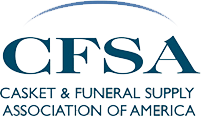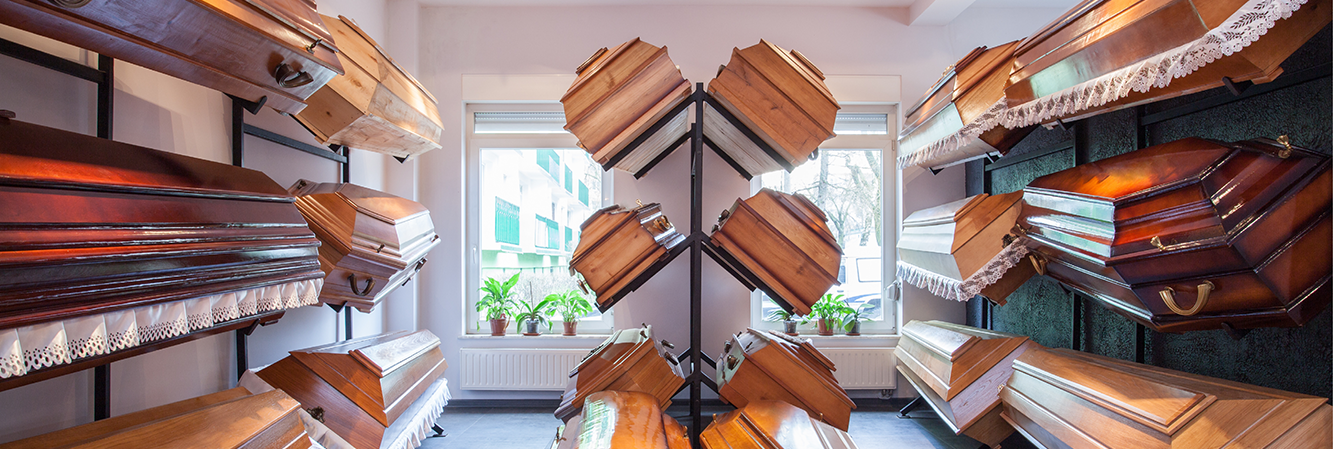The Casket Industry
 Casket manufacturing, as an industry, didn’t develop in the United States until the 1800’s. Prior to this time, local funeral directors – then known as undertakers – typically operated the town furniture store and built caskets on an as-needed basis. By the late 1800s, casket manufacturing developed as a distinct business and manufacturers devoted their efforts to the production and sale of coffins and caskets. Generally, casket manufacturers operated in local and regional markets until well into the 20th century.
Casket manufacturing, as an industry, didn’t develop in the United States until the 1800’s. Prior to this time, local funeral directors – then known as undertakers – typically operated the town furniture store and built caskets on an as-needed basis. By the late 1800s, casket manufacturing developed as a distinct business and manufacturers devoted their efforts to the production and sale of coffins and caskets. Generally, casket manufacturers operated in local and regional markets until well into the 20th century.
Products provided by the early industry included cloth covered caskets, hardwood caskets and metal caskets (some with inner liners and “glass sealing” mechanisms). By the early 1950s, it is estimated there were more than 700 casket manufacturers with more than 20,000 employees in the United States.
In 1950, more than half of all caskets sold were cloth-covered. Hardwood caskets represented about 18% of the industry’s unit volume with metal caskets comprising the remainder of the adult market. Children’s caskets represented about 6% of the total market.
After the Korean War, sheet steel became more readily available and the industry’s metal manufacturing activity and metal casket production grew rapidly. By the mid-1950s, metal caskets represented more than one-third of industry production. That doubled to two-thirds of the industry’s volume by the mid-1970s.
The change in product and consumer demand significantly affected the industry. Metal manufacturing required greater capital investment in manufacturing equipment and facilities. Metal stamping, welding, grinding, sanding and finishing (painting) equipment was required. Later, emission limits established by the Environmental Protection Agency added cost for emission control equipment required to minimize emissions that were deemed hazardous to the environment. In addition, national distribution systems came into being assisted by the growth of the interstate highway system.
Small, marginal manufacturers found it increasingly difficult to compete effectively. By 1967, the Census of Manufacturers reported there were 523 entities in the industry with 16,800 employees. By 1992, the number had shrunk to 211 producers employing 7,800 persons and in 2003, the Bureau of the Census listed it at 147 establishments with payrolls. Shipments were valued at $871.5 million; employment was 5,885 and the total industry payroll was $160 million.
The growing cremation rate adds to pressures on industry manufacturers and distributors by reducing the potential market. For decades, the cremation rate in the United States held steady at less than 4%. However, the cremation rate began to increase in the early 1970s, reaching nearly 10% of total deaths by 1980. By 1990, it was up to 17% and in 2006, it hit roughly a third of all deaths. As a result, the market for traditional funerals with traditional caskets declined at a time when, in spite of consolidation, production capacity exceeded demand for the product.
While several primary casket manufacturers build their own hardware and make their own interior designs and panels, a few companies provide decorative and functional hardware for the remaining casket manufacturers. Another small group provides interior materials for the casket industry, although many manufacturers and some distributors manufacture, sew and install their own interior cloth linings, bed and pillow covers, and head and foot panels.
In the 1960s, National Casket Co. and Boyertown Casket Co. were publicly traded on the Philadelphia and New York stock exchanges, respectively. In the early 1970s Hillenbrand Industries (HB), which owns Batesville Casket Co., became a publicly held company (NYSE). Gulf & Western Corp., from the late 1970s until 1982 owned several casket companies. It divested its casket industry assets in 1982 to AMEDCO, Inc., which traded on the NASDAQ exchange. AMEDCO was sold in 1986 to Service Corporation International (SRV: NYSE) and became known as the funeral supply division of SCI, which later acquired the assets of Boyertown Casket Co. In 1990, SCI divested itself of the funeral supply division. Casket production assets were acquired by private investors who renamed the division The York Group, Inc. With a public offering of stock in April 1996, The York Group joined Hillenbrand Industries as the only remaining publicly traded companies with interests in casket manufacturing. The assets of the York Group were acquired by Matthews International Corporation (MATW) in December 2001.
In the 1950s, almost every casket company manufactured cloth-covered caskets. Today, there are no more than 30-35 companies manufacturing such products. Most of these companies manufacture for local markets. Several companies manufacture most of this product line with regional or national distribution.
Because production is concentrated, most caskets tend to be standard products. Smaller manufacturers continue to produce custom products for their customers. In addition, many distributors offer custom products with installation of special exterior hardware and interior panels. Personalization is an increasingly significant aspect of casket production, and all major manufacturers offer personalized embroidery for interior casket panels and additional features to personalize the casket as the family of the deceased may wish.
In 1982, the Federal Trade Commission classified casket manufacturing as a concentrated industry with significant impediments to entry of new companies. Substantial capital is required to purchase existing manufacturers or to become a new manufacturer in the industry. There are seven companies that stamp metal casket components (K-D parts) and fewer than a dozen manufacturers assemble well over 90% of all metal caskets sold in the US. Three companies produce an estimated 80% of all caskets sold annually.
Further complicating entry into the industry are discounting practices and demands that reduce available margins needed to recover capital costs. Large publicly traded funeral home chains demand discounts from their suppliers and similar demands are increasingly made by other customers. While several large manufacturers are able to comply with the demand for discounts and special product lines, it is difficult for most industry entities to meet those demands. New entrants find it even more difficult to compete, given the capital cost associated with developing a new business in the casket industry.

